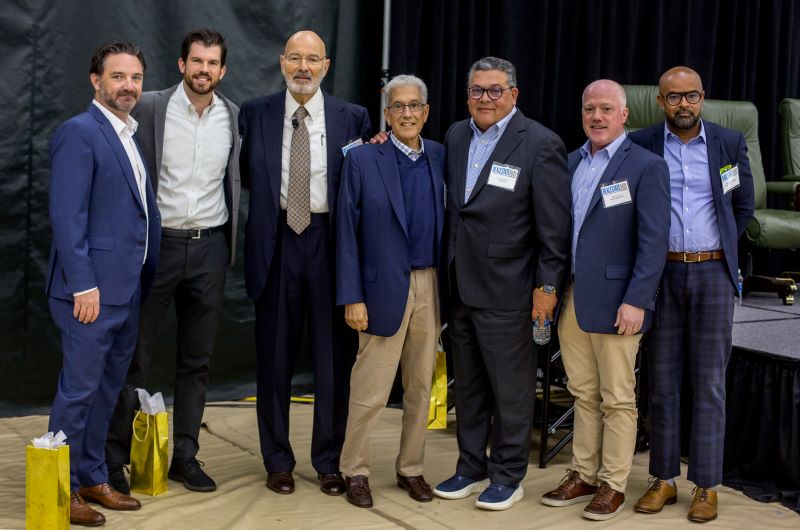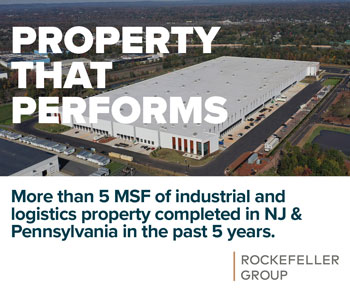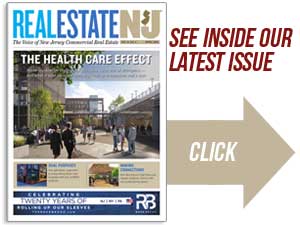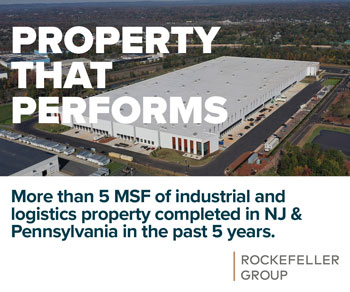From left: Walker & Dunlop Managing Director Tom Walsh, L+M Development Managing Director Sam Chapin, Real Estate NJ Publisher Paul V. Profeta, Fidelco Realty Group Chairman Marc Berson, CSG Law Member Frank Giantomasi, Onyx Equities Managing Partner John Saraceno and Murphy Schiller & Wilkes LLP Director Of Planning and Development Services Chris Watson were on hand for Real Estate NJ’s Newark Redevelopment Update at New Jersey Institute of Technology’s campus. — All photos by Aaron Houston for Real Estate NJ
By Joshua Burd
If there were any doubt about the type of strong, steadfast support that Newark has long enjoyed from its anchor institutions, Frank Giantomasi points to the city’s South Ward, where Newark Beth Israel Medical Center is in the midst of a $150 million expansion project.
According to the veteran real estate attorney, it’s also a sign of what’s still to come.
“It’s the single-largest development in the South Ward in the history of Newark,” said Giantomasi, a city native and member of the real estate, development and land use group at Chiesa Shahinian & Giantomasi PC. “If that’s not indicating that these are the best of times and that we’re just on a launching pad, I don’t know what else to say.”
Optimism is nothing new for the state’s largest city, with its rich transportation network, cultural institutions and key anchors in business, health care and academia. But Newark still struggles with poverty, education challenges and other barriers that have kept it from blossoming alongside places such as Jersey City and Hoboken, despite billions of dollars in new investment.

Panelists said as much last week during Real Estate NJ’s Newark Redevelopment Update — which drew a registered attendance of more than 500 to the New Jersey Institute of Technology campus — as they debated those challenges and how to unlock the city’s long-held potential.
“We are experiencing a constant flow of inquiry into Newark,” Giantomasi said. “People see this for all the good that’s here … but there are structural deficiencies that exist.”
Despite those hurdles, he added, “people with vision, the people that are supporting this event today … (are) here because they see opportunity, and that’s the essence for why the clients are coming into my office.”
Sam Chapin, a managing director with L+M Development Partners, said there is an “institutional infrastructure” in Newark that is pro-development and pro-growth. He pointed to the role of Rutgers University and Prudential Financial in L+M projects such as Hahne & Co. and Walker House, which rehabilitated vacant commercial buildings on Broad Street to create new mixed-use destinations, including hundreds of apartments.
Yet Newark’s housing stock remains undersupplied, panelists said, especially for a place with so many large employers.

“It costs a lot of money to own two cars,” said Marc Berson, chairman of Fidelco Realty Group. “It’s a lot easier to have one car and be able to walk to work and to dinner and the like, so I think we’re at an interesting point in time, because there’s also pressure out of Hoboken, out of Jersey City. The price is so high, and that means you’re pushing to Newark. I think it’s going to be seen for the opportunity, and all of us have a chance to get creative and invest.”
The longtime Newark business leader and philanthropist also cited the need to retain the graduates of NJIT, Rutgers-Newark and the city’s other colleges and universities. Companies such as Audible are working to change that, Berson said, pointing to the audio book giant’s investments in startups that have located and leased office space in Newark.
“It’s becoming a terrific community, which is pro-Newark and wants to live and work in the community,” he said. “And that’s one of the real opportunities that exists in Newark. We’ve come to a point where you can live and work.”
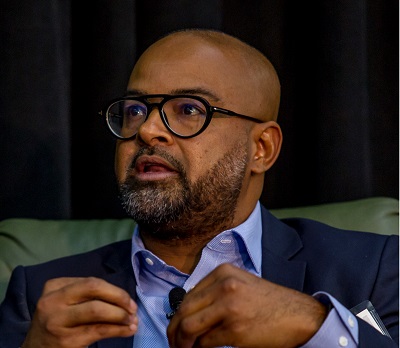
Christopher Watson, a former city planning officer, said there is an opportunity to create “a new definition of work from home” when residents are within mere walking distance of their office.
“Whether it’s life sciences or an architecture firm or a civil engineering firm, it’s the type of commercial opportunity that mirrors what these degrees are for,” said Watson, now the director of planning and development services with Murphy Schiller & Wilkes LLP, which is based in the city. “So here you have six universities and they’re giving every single degree. Why are we not having every single industry to trap them in place to work from home — home in Newark?”
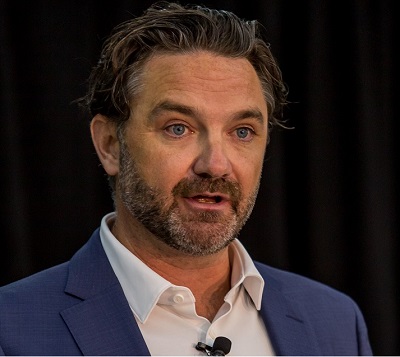
The June 7 panel discussion came as part of an event hosted by Real Estate NJ and presented by Walker & Dunlop, MSW and NJIT’s Paul Profeta Real Estate Technology, Design and Innovation Center. W&D Managing Director Tom Walsh moderated the discussion, which also featured Onyx Equities Managing Principal John Saraceno.
Panelists noted that Newark is structurally different from Jersey City and Hoboken, which have benefited from coordinated, concentrated development planning in specific neighborhoods or a smaller overall footprint. That likely obscures the activity that’s taking place throughout Newark’s 26 square miles, while also magnifying its challenges.
“It’s not like Jersey City, where they had a focus on the downtown. It’s not Hoboken where you only had to deal with one mile,” Giantomasi said. “Once you get a mile outside of downtown Newark … the land mass is that much greater to invest in.”

The event also took place only hours before Newark’s city council adopted an ordinance aimed at limiting rent increases at new, non-rent-controlled apartment buildings with fines of up to $1,200 for each unit in which a landlord raises rent by more than 5 percent in a single year. While Mayor Ras Baraka said the move would help tackle the city’s affordability crisis, critics argued it would stifle development and the creation of affordable housing, while suggesting it violated the state’s rent control law.
Giantomasi, speaking in general terms, said pro-tenant policies should come as no surprise in a city in which renters make up 70 percent of the population. He added: “I think the mayor’s first charge is to deal with the people that live here, sleep here every night.”

Chapin, meantime, noted that “there is real rental pressure” on tenants in Newark and throughout the region after a rapid rise in apartment costs. He also cited the importance of “development without displacement,” as L+M and others have built residential projects on vacant lots or by rehabilitating vacant buildings.
“That’s an important factor that shouldn’t go unnoticed here,” said Chapin, who is part of L+M’s LMXD team. “There’s very few, if any that I can think of, developments in which housing was razed in order to build new housing at a more expensive price.”
Still, he said, “there are secondary and tertiary pressures on existing housing stock when new housing comes to the market” and creates an opportunity for neighboring landlords to raise their rent. Cities can counteract that either through policy or by finding a way “to build more apartments and build them faster and arguably cheaper, because more supply will help the natural pressures on demand.”
“It’s a two-pronged approach,” Chapin said. “And I think, to the city’s credit … the level of new apartments and housing starts and entitlements over the past 10 years has been astronomical, so the city has committed to building more housing. On the other side, they’re also thinking about, ‘Well, how do we make sure that, while we run quickly, we know where we’re running to?’”
He noted earlier in the conversation that prospective renters at L+M’s properties frequently ask about homeownership opportunities in the city.
“Owning is a way of participating in the appreciation of markets,” Chapin said. Creating those opportunities is a challenge, he said, noting that it requires a first mover and requires capital providers that are willing to take that risk.
“I think it’s coming,” he added. “It’s just coming in time. And, as we’ve proven out the success of the rental market here, both with the rehabilitation work we’ve done and new construction work that others have done, the next step in that iterative growth plan is to start building homeownership opportunities.”
The discussion resonated with the crowd of executives, advocates and others who packed the room at NJIT’s Naimoli Family Athletic Center. It was a reminder that seemingly no other community in New Jersey enjoys the type of support and enthusiasm that Newark does, thanks in part to its untapped potential, but also the deep connection that business leaders and area residents feel to the city.

“There’s a passion about Newark, and there’s a sense of community about Newark, that doesn’t exist anywhere else in the state,” Onyx Equities’ Saraceno said. “And it puts that tremendous responsibility on you when you come here.”
Saraceno felt that enthusiasm firsthand in 2019 when an Onyx-led investment group closed on three of the four office buildings known as Gateway, where the team committed to a $50 million overhaul. In the subsequent days, he said, he was inundated by calls and messages from well-wishers and others offering their support and opinions about the city and the property.
“You try very hard not to get emotionally attached to a deal or an asset or a business plan, but Newark makes you become emotionally attached,” Saraceno added. “So the biggest driver for us and what we’ve continued to see is the sense of responsibility.”

